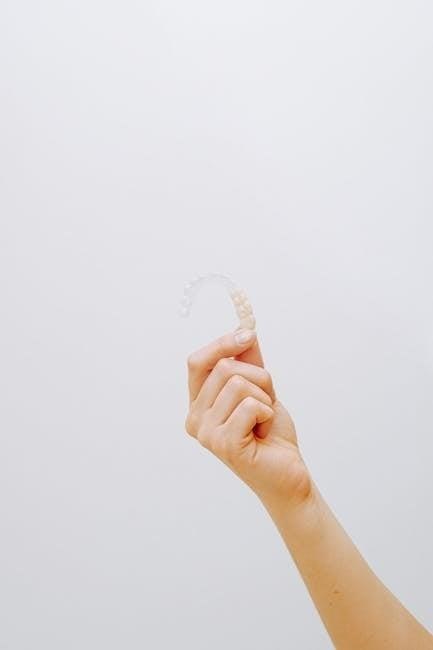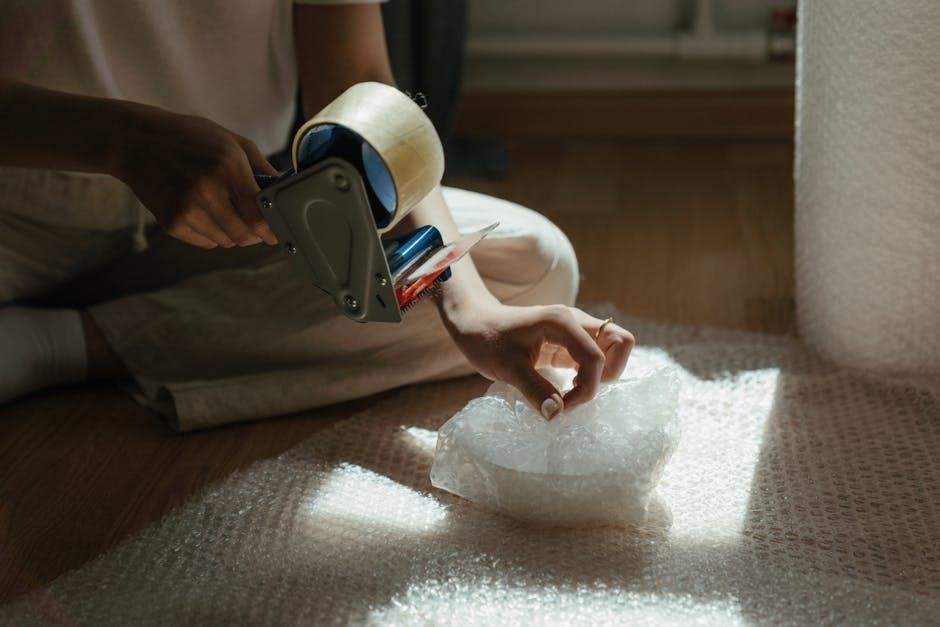Wearing aligners 20-22 hours daily is crucial for optimal results. Proper handling, cleaning, and following your doctor’s guidance ensure effective treatment and prevent damage to aligners.
1.1 Overview of Invisalign Treatment
Invisalign treatment involves clear, removable aligners that gradually straighten teeth. Custom-made using 3D scans and SmartTrack material, they are worn 20-22 hours daily. Each set is changed every 1-2 weeks, as directed. Patients receive a preview of their smile transformation and regular check-ups to monitor progress. Proper care includes cleaning with a toothbrush and avoiding damaging products. Retainers like Vivera are used post-treatment to maintain results.
1.2 Importance of Following Instructions
Adhering to your doctor’s instructions is vital for successful Invisalign treatment. Wearing aligners 20-22 hours daily ensures proper tooth movement. Neglecting instructions can lead to slower progress or misalignment. Proper handling and cleaning prevent damage, while consistent wear maintains treatment momentum. Compliance guarantees effective results and avoids potential setbacks, ensuring your smile transformation stays on track.
Initial Consultation and Treatment Plan
Your journey begins with a consultation using a state-of-the-art scanner to create a 3D smile map. This helps design a personalized treatment plan for your smile transformation.
2.1 Meeting with Your Doctor
Your initial consultation involves meeting with an Invisalign-trained doctor to discuss your smile goals. They’ll assess your teeth alignment and create a detailed 3D scan of your smile. This scan helps map out your custom treatment plan, ensuring you understand each step. Your doctor will also provide insights into what your new smile could look like, making the process transparent and personalized.
2.2 3D Scanning and Smile Mapping
Your doctor uses a state-of-the-art iTero Element scanner to create a precise 3D scan of your smile. This scan maps your current tooth alignment and helps design a personalized treatment plan. With this technology, you can preview your potential new smile, ensuring transparency and confidence in the process. The detailed scan also allows for accurate aligner fabrication and treatment monitoring using advanced ClinCheck treatment planning software.
2.3 Custom Treatment Plan Creation
Using the detailed 3D scan, your doctor creates a personalized treatment plan with ClinCheck treatment planning software; This plan outlines the exact movements of your teeth and the expected outcome. You’ll receive a preview of your new smile, ensuring alignment with your goals. The custom plan is tailored to your specific orthodontic needs, providing a clear roadmap for your Invisalign journey and ensuring precise results.
Wearing Your Invisalign Aligners
Aligners should be worn for 20-22 hours daily, except when eating, drinking, or cleaning teeth. Change aligners every 1-2 weeks as directed by your doctor.
3.1 Daily Wear Time Recommendations
Aligners should be worn for 20-22 hours daily, removing them only for eating, drinking, brushing, and flossing. Consistent wear ensures proper tooth movement and avoids delays. Aim to exceed 22 hours if possible, as less wear time may slow progress. Sticking to your doctor’s instructions is key for achieving the best results and maintaining treatment momentum effectively.
3.2 Handling and Storing Aligners
Always handle aligners with clean hands and store them in a protective case when not in use to prevent damage or loss. Avoid placing them in tissues or pockets, as they may be accidentally discarded. Keep aligners away from pets, who might be attracted to saliva residue. Use a soft toothbrush and mild soap for cleaning, and avoid harsh products like bleach or alcohol. Rinse aligners thoroughly before reinserting them. Storing aligners properly ensures they remain hygienic and effective throughout your treatment.

Cleaning and Maintaining Your Aligners
Clean aligners daily with a soft toothbrush and mild soap. Avoid harsh products like bleach or alcohol. Rinse thoroughly before reinserting to maintain hygiene and clarity.
4.1 Proper Cleaning Techniques
Use a soft toothbrush and mild soap to gently scrub your aligners. Avoid using harsh chemicals, bleach, or hot water, as they can damage the material. Rinse thoroughly with cold water to ensure cleanliness. Regular cleaning prevents bacteria buildup and keeps your aligners clear and odor-free. Proper maintenance ensures optimal comfort and effectiveness throughout your treatment.
4.2 Avoiding Damaging Products
Avoid using denture cleaners, alcohol, bleach, or hot water, as these can damage your aligners. Never soak them in boiling water or use abrasive materials, as this can warp or scratch the plastic. Refrain from chewing gum while wearing aligners, as it can stick to them and cause damage. Always clean your aligners with a soft toothbrush and mild soap to maintain their clarity and integrity.

Common Mistakes to Avoid
Not wearing aligners enough and improper cleaning are common mistakes. Ensure aligners are worn 20-22 hours daily and avoid using harsh products that can damage them.
5.1 Not Wearing Aligners Enough
Failing to wear Invisalign aligners for the recommended 20-22 hours daily can significantly delay treatment progress. Inconsistent wear prevents teeth from aligning properly, reducing the effectiveness of the treatment; It’s crucial to adhere to your doctor’s instructions to achieve the desired results. Neglecting wear time can lead to longer treatment duration and less optimal outcomes.
5.2 Using Improper Cleaning Methods
Using harsh products like denture cleaners, alcohol, or bleach can damage Invisalign aligners. Avoid hot water, as it may warp them. Instead, clean aligners with a soft toothbrush and mild soap. Improper cleaning can lead to discoloration or bacteria buildup, affecting both appearance and hygiene. Always follow your doctor’s cleaning instructions to maintain aligner integrity and ensure optimal treatment outcomes.

Additional Tools and Accessories
Attachments on teeth guide aligner fit, while bite sticks help seat aligners properly. These tools enhance treatment efficiency and ensure aligners function as intended for optimal results.
6.1 Attachments and Their Purpose
Attachments are small, tooth-colored shapes bonded to the front surface of teeth. They help aligners grip teeth, ensuring proper movement and stability. These bumps guide the aligners into place, enhancing treatment effectiveness. Proper fitting is crucial for optimal results. Avoid using harsh cleaners or hot water, as they can damage attachments. Regular check-ups ensure they remain intact and functional throughout treatment. Compliance with your doctor’s instructions maximizes their effectiveness.
6.2 Using Bite Sticks
Bite sticks are tools used to help seat aligners firmly over teeth. Patients are advised to chew on them for 10-15 minutes daily, applying gentle pressure across the full arch. This ensures aligners fit snugly, promoting proper tooth movement. Regular use helps maintain alignment and prevents shifting. Bite sticks are especially useful during initial stages when aligners may feel loose. Proper utilization enhances treatment efficiency and supports desired outcomes. Consistency is key.
Post-Treatment Care
After treatment, retainers are essential to maintain straight teeth. Vivera retainers, made with the same technology as Invisalign, are recommended for long-term results and stability.
7.1 Retainer Use and Importance
Retainers are crucial after Invisalign treatment to maintain your new smile. Vivera retainers, custom-made using Invisalign technology, are recommended for long-term stability. They prevent teeth from shifting back, ensuring your investment lasts. Proper retainer use is essential for retaining the alignment achieved through your treatment. Follow your doctor’s instructions for wear and care to enjoy lasting results.
7.2 Vivera Retainer Options
Vivera retainers are custom-made using the same advanced technology as Invisalign aligners, ensuring a precise fit and durability; They are clear, discreet, and designed for long-term use, making them an excellent choice for maintaining your smile. Crafted from high-quality materials, Vivera retainers are tailored to your specific needs, offering both comfort and effectiveness in preserving your orthodontic results.

Regular Check-Ups and Progress Monitoring
Scheduled check-ups with your doctor ensure your treatment progresses as planned. During these visits, your doctor will monitor tooth movement, provide new aligners, and address any concerns, ensuring optimal results.
8.1 Frequency of Appointments
Regular check-ups with your doctor are typically scheduled every 4-6 weeks to monitor progress. These visits allow your doctor to assess tooth movement, provide new aligners, and make necessary adjustments. Consistent appointments ensure the treatment stays on track and any issues are addressed promptly, maintaining the effectiveness of your Invisalign journey.
8.2 What to Expect During Check-Ups
Dental check-ups involve assessing aligner fit, monitoring tooth movement, and discussing concerns. Your doctor may provide new aligners, review progress, and offer care tips. These visits ensure treatment stays on track, addressing any issues promptly. Expect a thorough examination and guidance to maintain optimal results throughout your Invisalign journey.
Troubleshooting Common Issues
Address issues like lost or damaged aligners by contacting your doctor promptly. Ensure proper fit and avoid improper cleaning to maintain treatment progress and aligner integrity.
9.1 Lost or Damaged Aligners
If an aligner is lost or damaged, contact your doctor immediately. Wear your previous set until a replacement is provided to avoid treatment delays. Store aligners safely, away from pets, and avoid improper cleaning or exposure to heat, which can cause warping. Handle aligners carefully to prevent damage and ensure uninterrupted progress in your treatment plan.
9.2 Aligners Not Fitting Properly
If aligners feel loose or misaligned, consult your doctor promptly. Avoid forcing them into place, as this can cause damage. Use bite sticks as instructed to ensure proper seating. If issues persist, your doctor may adjust the treatment plan or attachments. Proper fit is essential for effective tooth movement and to avoid delaying results. Addressing fit concerns early ensures continued progress toward your desired smile.
Dietary Restrictions and Habits
Adhere to a diet avoiding sugary foods, coffee, tea, and red wine to prevent staining. Remove aligners before eating or drinking, except water. Avoid chewing gum and hard or sticky foods to prevent damage to aligners.
10.1 Foods and Drinks to Avoid
Avoid sugary foods, coffee, tea, and red wine to prevent staining. Remove aligners before eating or drinking, except water. Avoid chewing gum and hard or sticky foods to prevent damage. These items can stain or warp your aligners, hindering treatment progress. Stick to a diet of soft, non-abrasive foods and maintain good oral hygiene to ensure optimal results and aligner longevity.
10.2 Chewing Gum and Other Habits
Avoid chewing gum, as it can stick to your aligners and cause damage. Refrain from smoking, as it may discolor or damage the aligners. Additionally, avoid habits like biting nails or chewing on pens, which can warp or crack the aligners. These habits can interfere with treatment progress and reduce the effectiveness of your Invisalign journey. Maintain good oral habits to ensure optimal results and aligner durability.
Importance of Patient Compliance
Patient compliance is crucial for successful Invisalign treatment. Wearing aligners as directed and following instructions ensures proper tooth movement and avoids delays in achieving your desired smile.
11.1 Adhering to Wear Time
Adhering to the recommended 20-22 hours of daily wear is essential for effective tooth movement. Neglecting this can delay progress and prolong treatment. Consistency ensures optimal results, so avoid removing aligners excessively. Use a timer or reminders to track wear time. Proper adherence prevents teeth from shifting back, maintaining the alignment process. Stay committed to your schedule for the best outcome.
11.2 Avoiding Procrastination
Avoiding procrastination is key to successful Invisalign treatment. Delaying wear or neglecting to follow instructions can hinder progress and prolong treatment. Stay proactive by adhering to your schedule and maintaining consistent wear. Regularly monitor your progress and address any issues promptly. Procrastination can lead to misalignment and extended treatment time, so stay committed to your plan for optimal results and a timely outcome.
Consistent compliance, proper wear, and meticulous care ensure successful Invisalign results. Adhering to instructions and maintaining good oral hygiene guarantees a timely, effective treatment outcome and a perfect smile.
12;1 Recap of Key Instructions
Wear aligners 20-22 hours daily for optimal results. Clean them regularly with a toothbrush and mild soap, avoiding harsh products. Store aligners safely to prevent damage or loss. Attend all scheduled appointments and use retainers post-treatment. Avoid hot drinks, chewing gum, and improper cleaning methods. Stay committed to your treatment plan for the best outcome and a straight, healthy smile.
12.2 Final Tips for Success
Stay committed to your treatment plan and wear aligners as instructed. Use tools like bite sticks to ensure proper seating. Avoid damaging products and keep aligners clean. Attend regular check-ups and communicate openly with your doctor. Consistency is key to achieving the best results. Remember, your dedication will lead to a confident, straight smile that lasts a lifetime;
